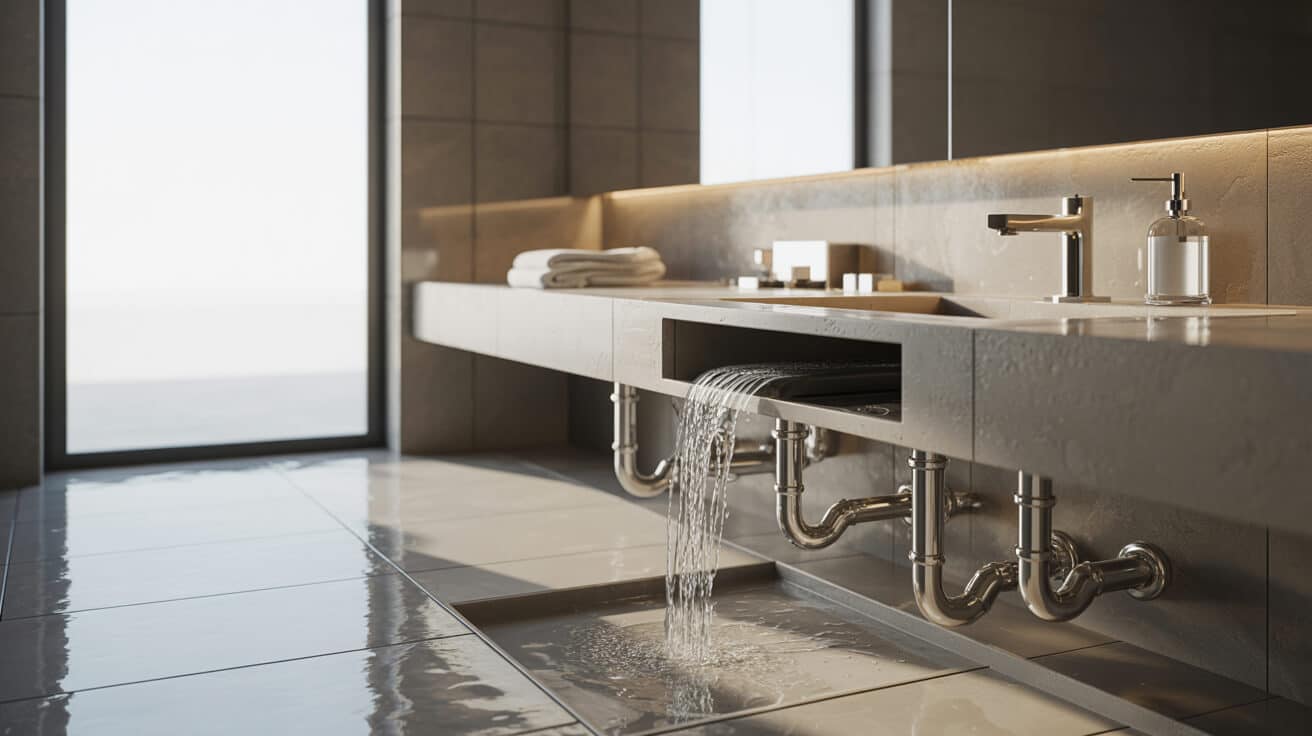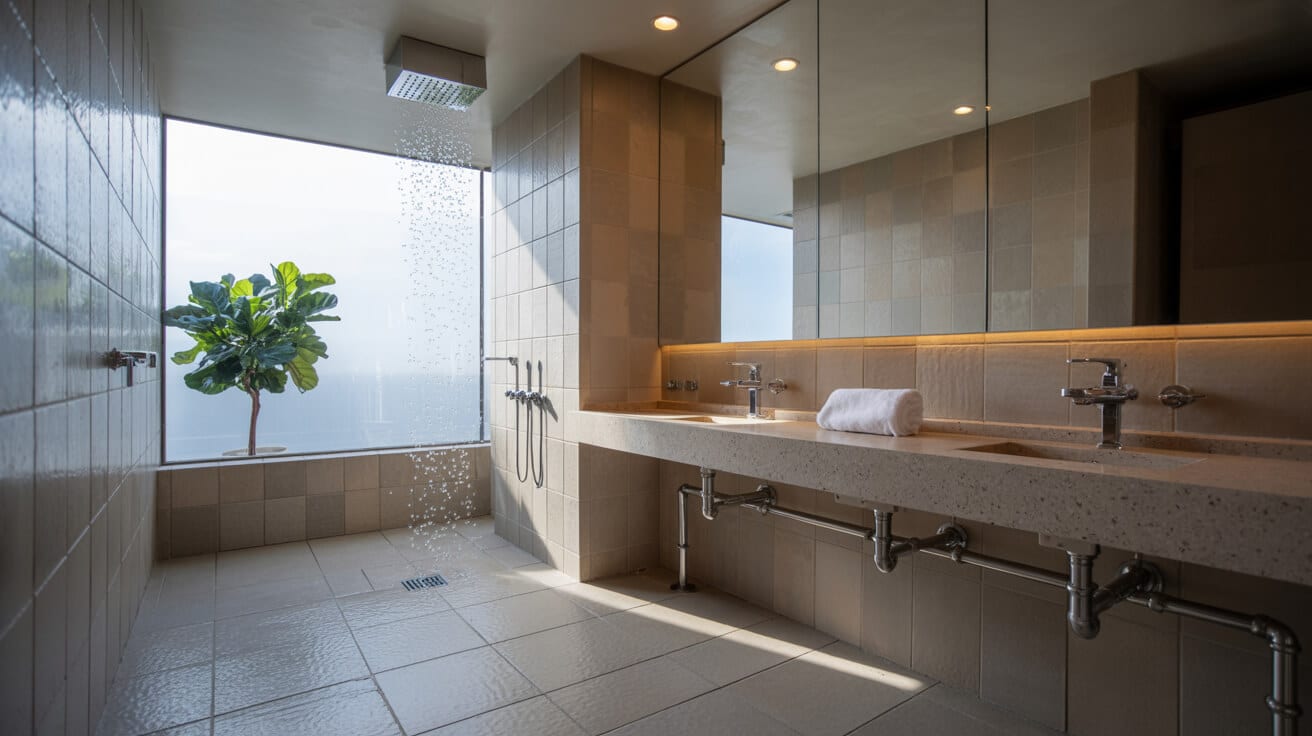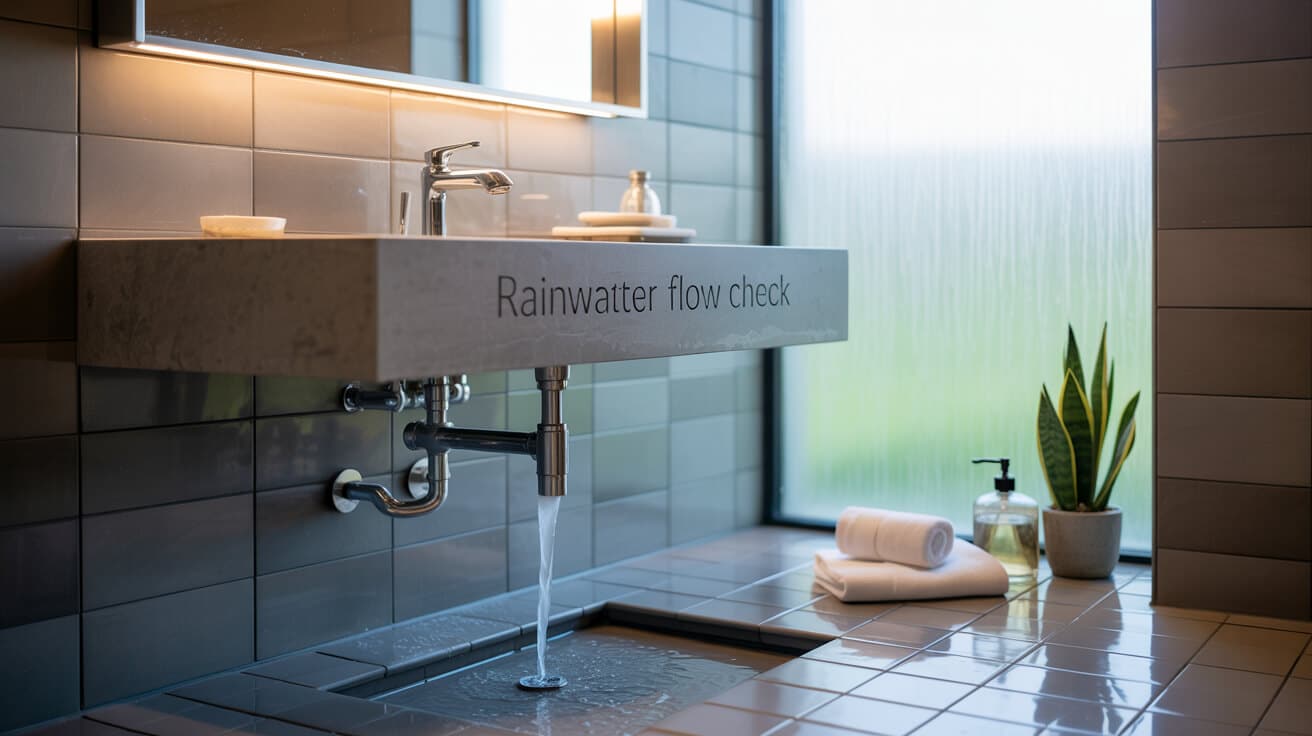A well-executed rainwater flow check involves more than surface-level observation; it is a dynamic intersection of preventative maintenance, regulatory compliance, and asset value protection. Your organisation’s approach to this discipline not only staves off property damage but also reinforces occupant confidence, strengthens asset portfolios, and answers to the emerging priorities of climate adaptation and urban sustainability. This synergy between technical vigilance and business resilience stands at the heart of modern facilities management.
Lead
A rainwater flow check comprises a systematic, multi-level evaluation of all devices and pathways intended to manage the passage of rainfall across a property’s surfaces and sub-surface structures. The process typically includes examination and functional testing of visible components such as gutters and downpipes, assessment of internal channels and inspection points, verification of final dispersal through gullies and soakaways, and data-driven reporting on system performance. Distinct from general maintenance, the flow check uses diagnostic measures ranging from simple water simulation to advanced recording equipment, with results influencing ongoing maintenance schedules, insurance documents, and regulatory reports.
Engineers and inspectors—such as the teams at Plumbers 4U—deploy flow checks both as part of scheduled maintenance and in response to environmental events, ownership transfer, or compliance audits. For your property, whether privately owned, managed as part of a letting arrangement, or held in commercial trust, integrating routine, high-accuracy flow checks reduces the frequency and cost of major repairs, limits service downtime, and demonstrates ongoing responsibility to tenants, insurers, and local authorities.
Etymology or name origin
The term “rainwater flow check” fuses the precise technical language of hydraulic engineering—where “flow” traces the path of liquid through planned channels—with an inspection ethos embedded in the culture of property management and building regulation. Usage of this composite phrase emerged as professional plumbing and heating services scaled, and as building codes codified the need for regular drainage system verification. Trade publications, manufacturer manuals, and statutory documents began using “flow check,” “drainage flow survey,” and “system performance audit” interchangeably, though nuance persists in application: a flow check implies a function-oriented assessment, not simply a visual review, and is recognised in compliance frameworks regulating asset handover, lease agreements, and post-incident procedures.
Overview / context
Rainwater control is fundamental to the enduring function of built environments, ensuring that roofs, facades, courtyards, landscaping, and adjacent pedestrian areas remain dry, stable, and fit for purpose. The architecture of these systems is driven as much by geography (climate, rainfall intensity) as by property use and local ordinances, but all rely on the seamless integration of collector surfaces, conveyance pipes, and dispersal zones.
Without active assurance mechanisms, sediment accumulation, structural failure, or external incursion (such as bird nests or vegetation) can quietly dissipate system capacity. Insurance claims following floods, chronic damp, or foundation failure often trace back to missed or inadequate rainwater flow checks. Evolving standards in both domestic and commercial asset management now demand explicit, periodic demonstration of drainage system performance as a condition for insurance premiums, lease renewals, or property resale.
Properties under professional management often layer digital records, photographic logs, and regulatory checklists atop traditional maintenance plans. As part of this, your documentation and scheduling of flow checks is no longer optional but integral to meeting obligations to residents, insurers, and the broader community.

History
Origins
Earliest approaches to safeguarding property from rainfall relied on site grading and stone or clay gutters, positioned to channel water from thresholds and footings. The concept of flow verification arose chiefly in dense settlements and public works, where drainage failures would yield societal risk in the form of impassable streets, stagnant water, or building collapse.
Industrial emergence
The mass adoption of cast iron, terracotta, and, in the twentieth century, plastics facilitated more intricate systems, integrating drainage directly into the construction phase. By this period, local by-laws and insurance contracts introduced mandatory inspection intervals, creating a professional class of inspectors. The industrial city—subject to routine flooding, urban runoff, and evolving sanitation codes—provided the laboratory for modern rainwater assessment.
Contemporary evolution
Today, scheduled flow checks are hardwired into property risk strategies. The last two decades have seen an influx of digital and sensor-based diagnostics, remote sensing, and large-scale compliance frameworks—especially in high-risk flood zones and multi-tenanted buildings. Service-oriented firms like Plumbers 4U have digitally aligned their processes, offering routine and reactive flow checks as part of integrated property care portfolios that now mirror best practice in sustainability, resilience, and tenant welfare.
Concept / description
Rainwater drainage depends on gravity to mobilise runoff from roofs and impervious surfaces, through collector gutters to downpipes and, ultimately, to channels or soakaways that return water to the environment or convey it to sewers. Each subsystem must be sized to local rainfall design standards and kept free from obstructions. Performance is regulated not only by hydraulic calculations but by field evidence—collected through a spectrum of diagnostic activities.
Core system components
- Gutters: Catchment channels at the roofline; may be continuous, sectional, or integrated with parapets.
- Downpipes: Vertical or angled pipes, sometimes with offsets or hoppers, bridging roof eaves and ground.
- Hopper heads and outlets: Connect multiple downpipes or direct flow into subsurface systems.
- Leaf guards and debris screens: Prevent ingress of organic material and wildlife, reducing blockage probability.
- Inspection points (rodding eyes, chambers): Essential access features for mechanical or camera surveillance.
- Gullies and soakaways: Below-ground dispersal, facilitating return to subsoil or, in urban environments, managed SuDS features.
Diagnostic stages
- Visual survey: Examines for tell-tale signs—staining, moss, deformation, standing water.
- Functional simulation: Introduces controlled water volumes to test flow and identify bottlenecks.
- Obstruction localization: Uses rods or pressure hoses to map and clear identified blockages.
- Advanced diagnostics: Applies dye or CCTV, especially in complex or concealed runs.
- Reporting: Documents findings in line with compliance, warranty, and insurance needs.
Functionality / purpose / applications
Preventative maintenance
A rainwater system’s unseen vulnerabilities can escalate into visible, disruptive failures with little warning. Preventative scheduling and thorough flow assessment allow your organisation to identify anomalies—such as slow drain rates, pooling water, or sediment buildup—before consequential damage occurs. For distributed portfolios, digital reminders and pre-scheduled maintenance via service partners like Plumbers 4U reduce missed intervals.
Asset preservation and value protection
A functional drainage regime is vital to the preservation of property value and the health of underlying infrastructure. Consistent documentation demonstrates a history of stewardship that defends against devaluation or adverse inspection outcomes during transaction, asset transfer, or regulatory review.
Insurance and legal compliance
Insurers increasingly rely on your inspection records to validate claims or qualify for coverage. For landlords, logged flow checks are often stipulated in lease agreements or as part of the handover documentation. Routine compliance both reduces premiums and signals diligence to stakeholders, influencing market positioning and risk profiles.
Stakeholder reassurance
For tenants, occupants, and facility users, clear evidence of maintenance routines builds trust and supports higher satisfaction metrics. The psychology of reassurance infuses every successful property management narrative; presenting inspection evidence alleviates doubt and preemptively answers objections from residents or regulatory bodies.
Classifications / types / variants
System architectures
- Gravity-fed systems: The most widely implemented, relying on vertical drop and slope.
- Siphonic systems: Deployed in large surface or flat-roofed buildings, leveraging vacuum differentials for higher capacity and self-clearing.
- SuDS-centric systems: Marry engineered devices with landscape features for managed infiltration; increasingly mandated in urban developments.
Assessment types
- Routine scheduled: Annually or biannually, commonly timed to seasons of highest rainfall or leaf fall.
- Event-triggered: Activated after severe weather, roof repairs, or incident reporting.
- Compliance-driven: Linked to legal, insurance, or management schedule requirements, with minimum frequency set by regulation or contract.
Contextual adaptations
Properties with complex terrains, historic status, or unique site conditions may require bespoke inspections, including manual mapping, heritage-sensitive interventions, or collaboration with architects and specialist surveyors.

Systems / tools / methodologies
Essential toolsets
| Tool | Functionality | Typical Usage Context |
|---|---|---|
| Ladders/work at height gear | Access to rooflines, gutters, downpipes | Universal |
| Telescopic camera | Remote inspection of inaccessible or fragile channels | Large/complex sites |
| Water hoses/jugs | Simulate rainfall to test built-system hydraulic performance | Standard (visual/function check) |
| Dye trace | Pinpoints slow-flow or hidden leakage routes | Deep diagnosis |
| CCTV or endoscope | Visualise sub-surface or concealed drainage branches | High-value buildings, recurring fault |
| Rods/pressure jet | Mechanical clearing of blockages and root intrusion | Responsive maintenance |
| Digital metres | Flow, velocity, or water level measurement for compliance | Commercial/industrial, SuDS |
Methodology sequence
For optimal results, organisations should: 1. Survey access: Confirm health and safety compliance and identify access points. 2. Conduct visual evaluation: Look for disconnects, deformation, or clear blockages. 3. Simulate or test flow: Observe water behaviour at representative outlets and dispersal points. 4. Deploy advanced diagnostics where warranted: e.g., unexplained flooding, insurance claim investigation. 5. Record meticulously: Log findings, time, date, weather context, and corrective actions for audit and handover.
Stakeholders / entities involved
Stakeholder mapping
| Stakeholder | Typical Responsibilities | Motivations/Outcomes |
|---|---|---|
| Homeowners | Schedule checks; fund remedial action | Protect property; lower insurance |
| Landlords | Log and report inspections; compliance | Reduce risk; preserve asset value |
| Letting agents/property managers | Coordinate scheduling, documentation | Compliance; client communication |
| Facilities managers | Oversee system performance, vendor liaison | Continuity of service; legal compliance |
| Contractors/engineers | Assess, remedy, report findings | Regulatory; professional standing |
| Local authorities | Enforce standards; review compliance | Infrastructure reliability; community safety |
| Insurers | Audit records, process claims | Risk adjustment; claim disbursement |
Successful execution of rainwater flow checks in communal buildings often hinges on transparent communication and coordination between parties, especially where responsibilities for external and internal drainage diverge.
Legal / regulatory / ethical considerations
Codes and regulatory drivers
| Regulation/Standard | Applicability | Core Requirements |
|---|---|---|
| Part H (UK Building Regs) | All new builds/renovations | Efficient drainage; periodic functional validation |
| Water Regulations Advisory Scheme (WRAS) | All potable/non-potable installations | Approved parts/methods; regular inspection |
| Local authority surface water ordinances | Varied | Limits on storm surge/runoff; asset documentation |
Legal and insurance interplay
Failure to evidence interval-based system inspections can result in voided insurance claims or significant financial exposure following flooding. For landlords and agencies, lack of routine documentation can disrupt asset transfer, raise disputes with tenants, or expose your business to action for negligence under property law.
Ethics and stewardship
Professional teams, including those at Plumbers 4U, bear a duty to address risks proactively, recommend sustainable solutions where possible, and use environmentally responsible tools or products. Documenting and disclosing deficiencies—rather than simply fixing surface symptoms—contributes to a culture of trust and property resilience.
Performance metrics / data / measurements
Key performance indicators
- Flow integrity: All system components permit full water passage without backup observed under both routine and simulated loads.
- Drainage time: Measured interval from rainfall simulation start to completion across test catchment area.
- Blockage incidence: Frequency and type of obstruction over inspection cycles—an early indicator of system design adequacy or usage issues.
- Overflow recording: All overflow events (even minor) must be time- and context-stamped to distinguish recurring vulnerabilities.
- Documentation quality: Each check accompanied by photographic/video evidence and clear, dated service logs.
For larger or high-occupancy properties, introducing a compliance scorecard tracks inspection dates, observation outcomes, remedial actions, and responsible parties.
Challenges / barriers / limitations
Physical and technical constraints
- Inaccessible components: Legacy or remodelled buildings may lack compliant access points, requiring partial dismantling or non-invasive detection.
- Hidden defects: Some failures (e.g., slow leaks or partial blockages) may evade visual discovery and only manifest during prolonged wet periods.
- Variable standards: Fragmentation of local regulation, guidance, or insurable maintenance frequency can create confusion among property owners.
Economic and organisational factors
- Maintenance budget pressures: Deferred maintenance may yield a short-term saving but set the stage for higher long-term cost outlays and lost revenue due to inhabitable spaces.
- Ownership transitions: Asset stewardship breakdowns are common at sale, tenant move-in/move-out, or contractor changeovers.
- Responsibility diffusion: Where property management is diffuse or intermittent, the “someone else’s problem” syndrome may emerge, increasing systemic risk.
Social and philosophical dimensions
A culture shift toward proactive rather than reactive management remains uneven—not all property stakeholders recognise the systemic or moral imperative of scheduled rainwater drainage care. As environmental awareness grows, expectation is mounting on organisations to both evidence duty of care and minimise broader community impacts from mismanaged drainage.
Impact / influence / legacy
Tangible value
- Reduced property risk: Quantifiable reduction in claims, loss events, and unscheduled repairs for properties under scheduled assessment regimes.
- Market differentiation: Documented maintenance records can serve as trust signals in transactions, letting markets, and compliance reviews.
- Community assurance: Building a culture of reliability and stewardship predicates safer, more desirable communities—especially for high-density, multi-occupancy, or publicly accessible properties.
Empathetic advantage
- The relationship between service providers (like Plumbers 4U), property managers, and end users is strengthened through transparent communication, accessible recordkeeping, and prompt response to identified needs.
- Enthusiastic adoption of check routines by organisations and local authorities signals alignment with rising tenant, insurer, and regulatory expectations.
Future directions, cultural relevance, and design discourse
Emerging technologies
- Enhanced materials and self-healing surfaces for gutters and gullies, reducing manual maintenance intervals.
- Remote moisture and flow detection—data-driven escalation triggers and smarter prioritisation across portfolios.
Regulatory and market trends
- SuDS integration is moving from commercial to domestic mandates, requiring data-supported evidence of function.
- Tighter insurance and lending requirements increase frequency and depth of inspections—not only for new builds, but on all asset classes.
Cultural shift
- Growing urban and climate vulnerability places new value on “maintenance intelligence” and the visibility of risk management as a property asset.
- As more stakeholders internalise the language and expectation of regular, professionally executed flow checks, a new norm emerges: proactive, data-driven, and demonstrably ethical facilities stewardship.
- Service brands such as Plumbers 4U—through value-led communication, reliability, and transparency—stand as exemplars of this evolution in the property management landscape.

